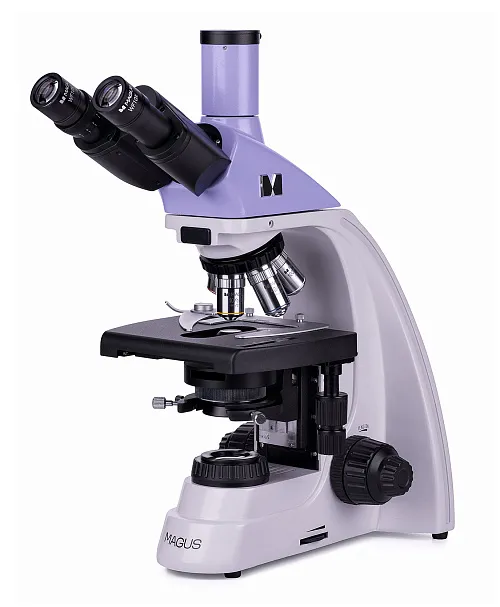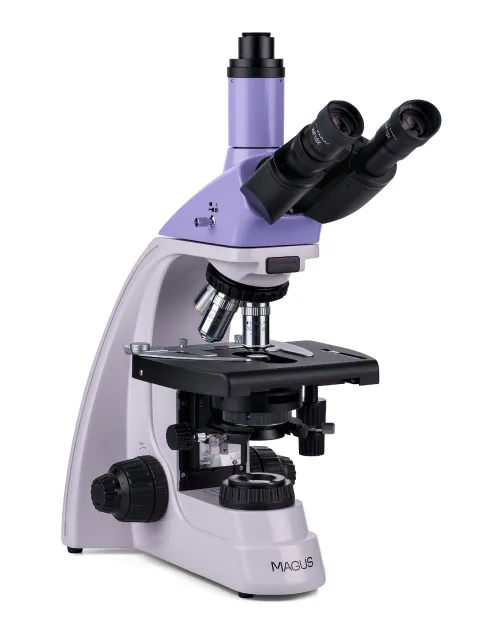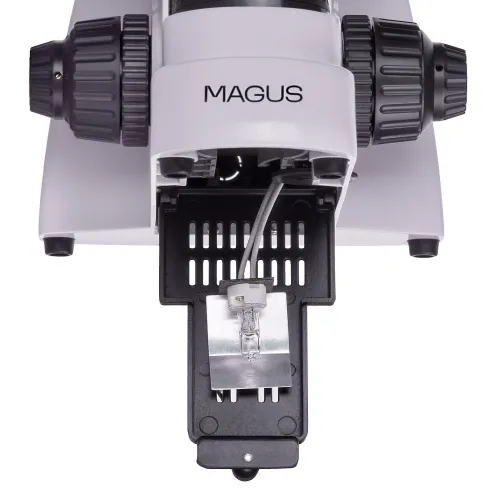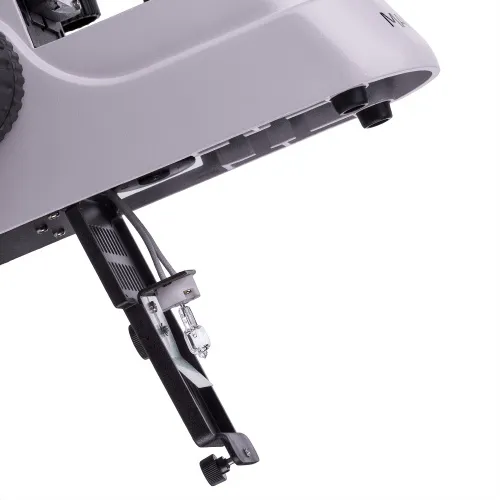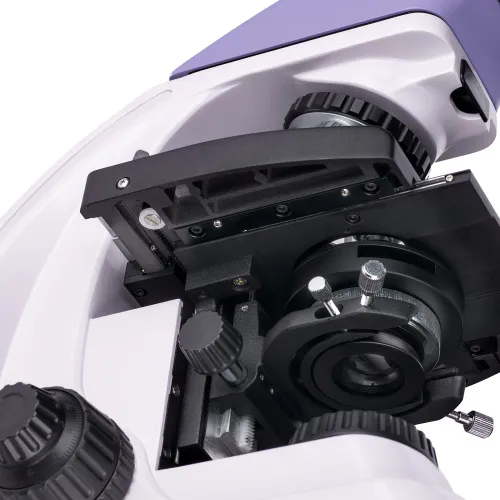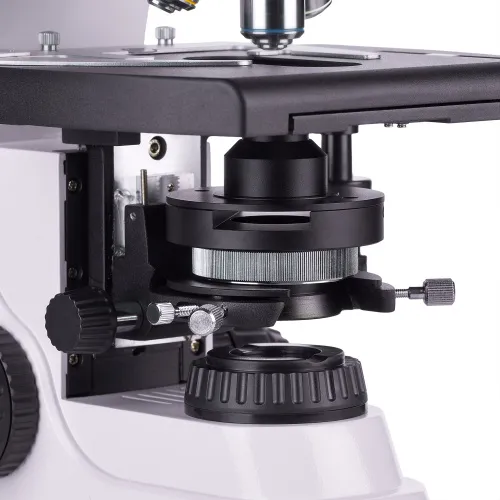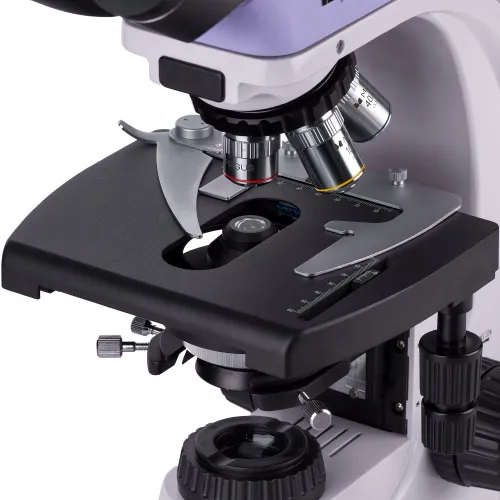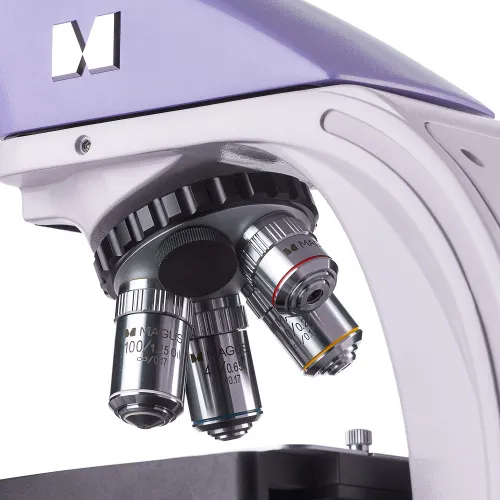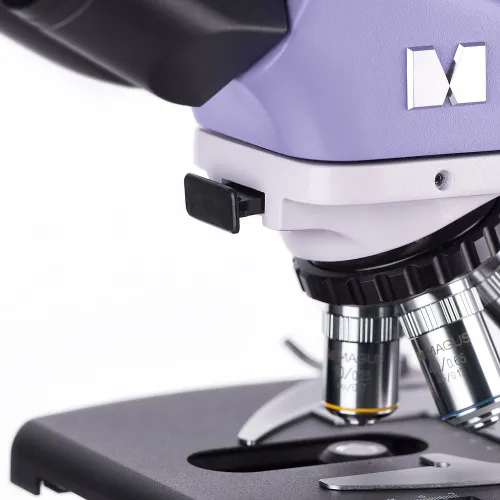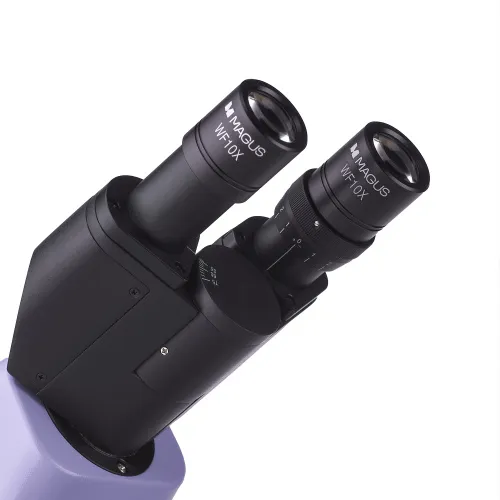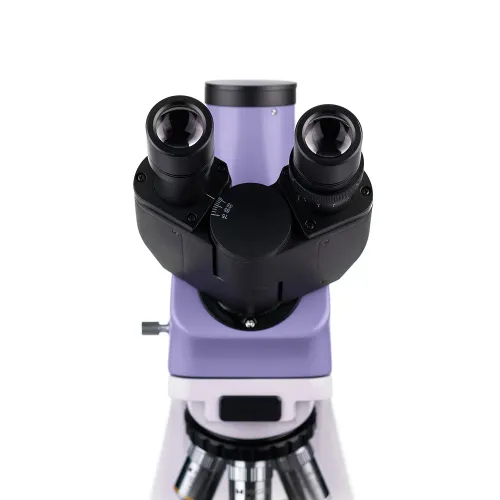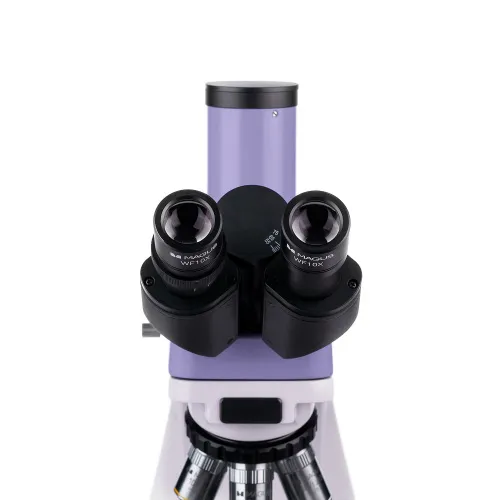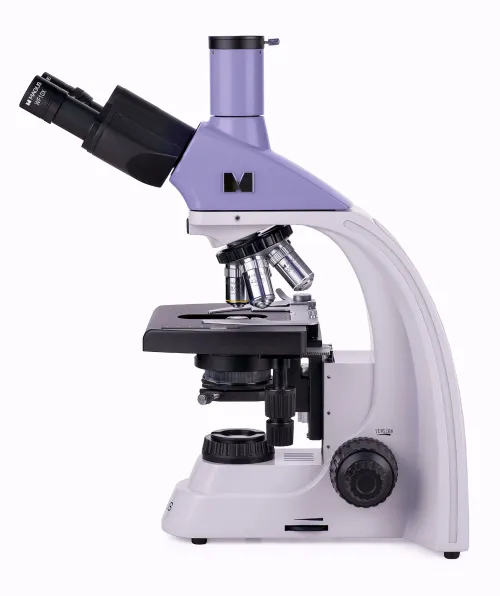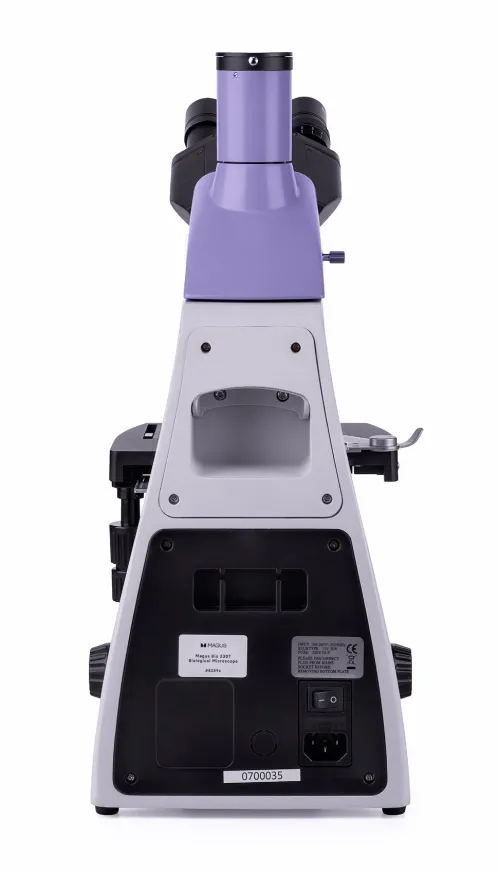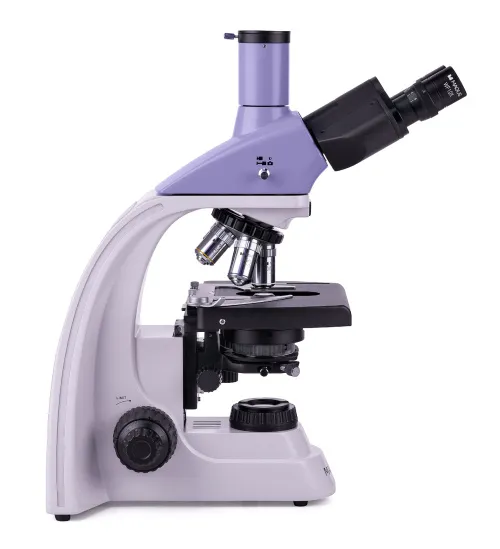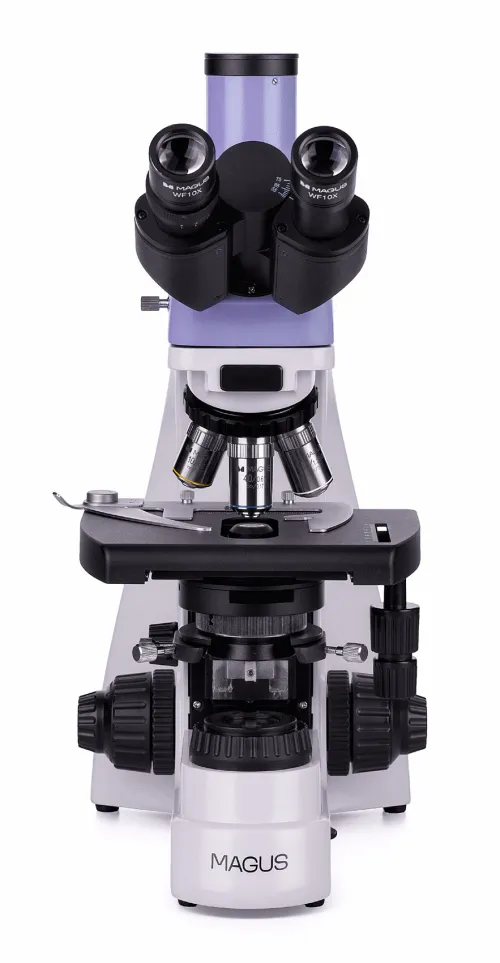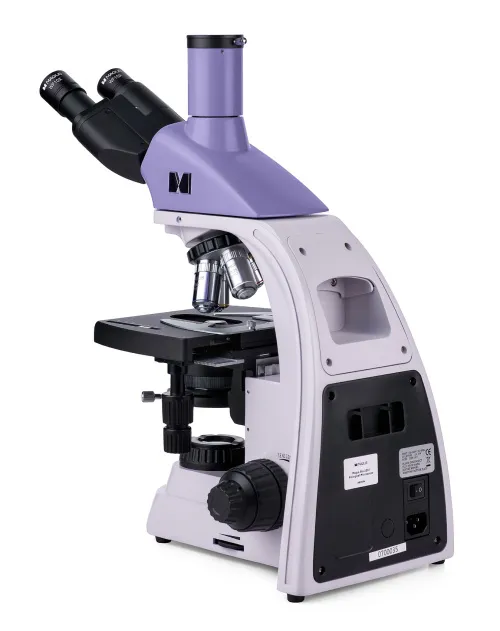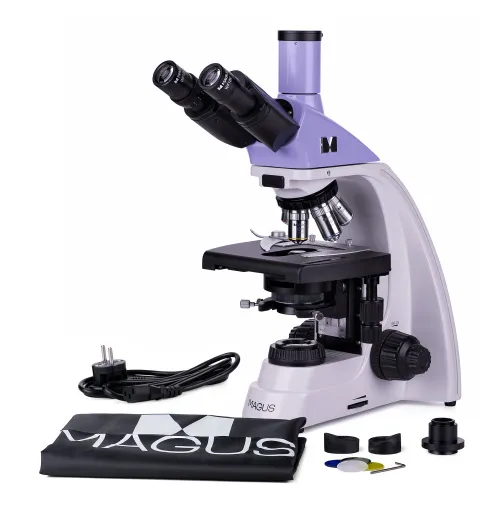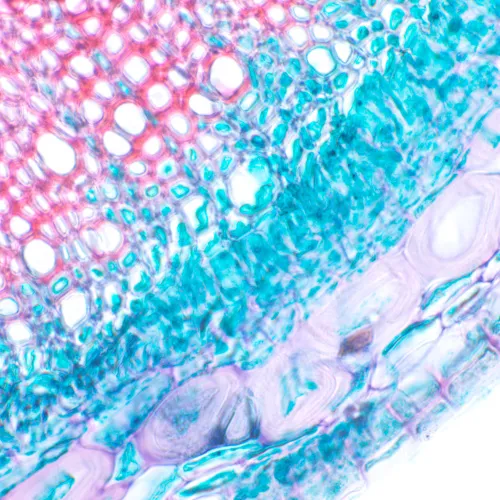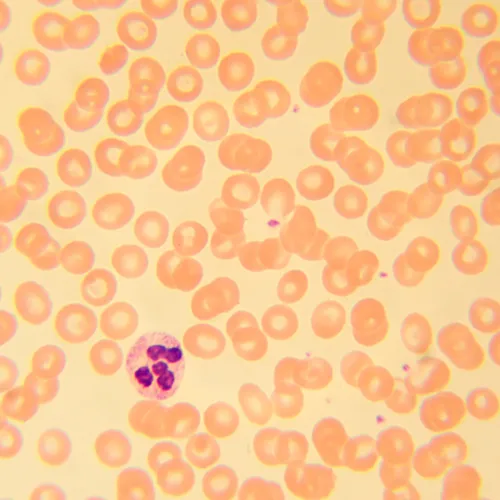MAGUS Bio 230T Biological Microscope
Magnification: 40–1000x. Trinocular head, achromatic objectives, 30W halogen bulb
| Product ID | 82894 |
| Brand | MAGUS |
| Warranty | 5 years |
| EAN | 5905555017938 |
| Package size (LxWxH) | 43x27x63 cm |
| Shipping Weight | 10.5 kg |
MAGUS Bio 230T is a biological trinocular microscope for laboratory and research observations in the field of medicine, pharmaceuticals, forensics, biotechnology, etc. It is suitable for the observation of flat biological translucent and transparent specimens: thin sections and smears. Equipped with achromatic objectives and a halogen bulb, the transmitted light microscopy technique (brightfield) is used for studying samples. The design of the microscope provides the possibility of installing additional accessories that allow for the use of other microscopy techniques: darkfield, phase contrast, polarized light.
Optics
The trinocular head has a vertical tube for mounting a digital camera. The camera (not included) is an excellent solution for making digital archives of your studies and output images to an external monitor screen. To adjust the observation tubes to fit the user’s height, there is an option to rotate them 360°. The left tube is equipped with a diopter adjustment ring.
The revolving nosepiece is oriented toward the interior, which leaves the space above the stage free. Five objectives can be simultaneously mounted into the nosepiece (4 objectives are included in the kit and the 5th slot is left for an additional objective). In the basic configuration, the infinity-corrected objectives provide magnification from 40 to 1000x. With optional eyepieces, the upper limit can be increased up to 1500, 1600, or 2000x.
Illumination
The halogen bulb produces warm-spectrum lighting that reduces eye strain and is ideal for long hours of working with the microscope. The bulb is 30W and, therefore, the brightness and contrast of the transmitted image is high regardless of the type of objective or observation technique being used.
The Abbe condenser is height-adjustable and can be centered. The illumination is controlled by adjusting the iris and field diaphragms, and there is an option to set up the Köhler illumination for better image clarity. The condenser has a slot for installing a phase or darkfield slider, which speeds up the process and makes it easier to switch between different microscopy techniques.
Stage and focusing mechanism
There is no positioning rack on the stage. This is an advantage of the mechanical stage design as it makes it easier to operate the microscope. The specimen can be moved smoothly across the stage. The mechanical attachment is removable (it can be removed for manual scanning).
There is coarse and fine focusing adjustment, the focusing knob movement is smooth and easy, and it requires no further effort. The coarse focusing mechanism has a lock knob and tension adjustment. The focusing knobs are coaxial, positioned for maximum comfort during long hours of observation, and are located at the microscope base so that you can comfortably rest your hands on the table.
Accessories
To maximize the capabilities of the MAGUS Bio 230T microscope, you can further upgrade it with some accessories. It may include eyepieces and objectives, digital cameras and calibration slides, darkfield condensers, polarized light, and phase contrast microscopy observation devices.
Key features:
- Trinocular head with a vertical tube for mounting a digital camera
- The 360° rotation to fit the height of the observer
- Infinity achromatic objectives, revolving nosepiece for 5 objectives
- Diopter adjustment ring on the left tube
- 30W halogen bulb powered by AC power supply, Abbe condenser with a slot for darkfield and phase contrast sliders, field diaphragm
- Coaxial coarse and fine focusing knobs, lock knob and coarse tension adjustment knob
- Optional accessories to improve microscope performance
The kit includes:
- Base with a power input, transmitted light source, focusing mechanism, stage, condenser mount, and revolving nosepiece
- Abbe condenser
- Trinocular head
- Infinity achromatic objective: 4x/0.10
- Infinity achromatic objective: 10x/0.25
- Infinity achromatic objective: 40x/0.65 (spring-loaded)
- Infinity achromatic objective: 100x/1.25 oil (spring-loaded)
- Eyepiece 10x/18mm with a long eye relief (2 pcs.)
- Eyecup (2 pcs.)
- Filter (4 pcs.)
- C-mount camera adapter
- Bottle of the immersion oil
- AC power cord
- Dust cover
- User manual and warranty card
Available on request:
- 10x/20mm eyepiece with a scale
- 15x/11mm eyepiece (2 pcs.)
- 16x/11mm eyepiece (2 pcs.)
- 20x/11mm eyepiece (2 pcs.)
- Infinity achromatic objective: 20x/0.40
- Infinity plan achromatic objective: 20х/0.40
- Infinity plan achromatic objective: 60x/0.80 (spring-loaded)
- Phase-contrast device
- Phase slider
- Darkfield condenser NA 0.9
- Oil darkfield condenser NA 1.36–1.25
- Darkfield slider
- Polarization devices
- Digital camera
- Calibration slide
- LCD Monitor
| Product ID | 82894 |
| Brand | MAGUS |
| Warranty | 5 years |
| EAN | 5905555017938 |
| Package size (LxWxH) | 43x27x63 cm |
| Shipping Weight | 10.5 kg |
| Type | biological, light/optical |
| Microscope head type | trinocular |
| Head | Gemel head (Siedentopf, 360° rotation) |
| Head inclination angle | 30 ° |
| Magnification, x | 40 — 1000 |
| Magnification, x (optional) | 40–1500/1600/2000 |
| Eyepiece tube diameter, mm | 23.2 |
| Eyepieces | 10х/18mm, eye relief: 10mm (*optional: 10х/20mm with a scale, 15x/11mm, 16x/11mm; 20x/11mm) |
| Objectives | infinity achromatic: 4x/0.10; 10x/0.25; 40xs/0.65; 100xs/1.25 (oil); parfocal distance 45mm (*optional: 20x/0.40; 60xs/0.80) |
| Revolving nosepiece | for 5 objectives |
| Working distance, mm | 18.89 (4x); 5.95 (10x); 0.775 (40xs); 0.36 (100xs); 2.61/8.80 (20x); 0.46 (60хs) |
| Interpupillary distance, mm | 48 — 75 |
| Stage, mm | 180x150 |
| Stage moving range, mm | 75/50 |
| Stage features | two-axis mechanical stage, without a positioning rack |
| Eyepiece diopter adjustment, diopters | ±5 (on the left tube) |
| Condenser | Abbe condenser, N.A. 1.25, center-adjustable, height-adjustable, adjustable aperture diaphragm, a slot for a darkfield slider and phase contrast slider, dovetail mount |
| Diaphragm | adjustable aperture diaphragm, adjustable iris field diaphragm |
| Focus | coaxial, coarse focusing (21mm, 39.8mm/circle, with a lock knob and tension adjusting knob) and fine focusing (0.002mm) |
| Illumination | halogen |
| Brightness adjustment | ✓ |
| Power supply | 220±22V, 50Hz, AC network |
| Light source type | 12V/30W halogen bulb, G4 |
| Light filters | yes |
| Operating temperature range, °C | 5...+35 |
| Ability to connect additional equipment | phase contrast device (condenser and objectives), darkfield condenser (dry or oil), polarization devices (polarizer and analyzer) |
| User level | experienced users, professionals |
| Assembly and installation difficulty level | complicated |
| Application | laboratory/medical |
| Illumination location | lower |
| Research method | bright field |
| Pouch/case/bag in set | dust cover |
| Weight, kg | 8 |
| Dimensions, mm | 200x436x400 |
We have gathered answers to the most frequently asked questions to help you sort things out
Find out why studying eyes under a microscope is entertaining; how insects’ and arachnids’ eyes differ and what the best way is to observe such an interesting specimen
Read this review to learn how to observe human hair, what different hair looks like under a microscope and what magnification is required for observations
Learn what a numerical aperture is and how to choose a suitable objective lens for your microscope here
Learn what a spider looks like under microscope, when the best time is to take photos of it, how to study it properly at magnification and more interesting facts about observing insects and arachnids
This review for beginner explorers of the micro world introduces you to the optical, illuminating and mechanical parts of a microscope and their functions
Short article about Paramecium caudatum - a microorganism that is interesting to observe through any microscope

